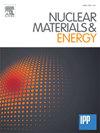Hermes-3 simulation of the low-n X-point mode driven by impurity in tokamak edge plasmas
IF 2.7
2区 物理与天体物理
Q1 NUCLEAR SCIENCE & TECHNOLOGY
引用次数: 0
Abstract
Hermes-3, a multi-fluid plasma simulation tool is applied to investigate the low-n X-point mode driven by coupling between drift wave and impurity radiation condensation instability in tokamak edge plasmas. The radiation loss function of impurities under noncoronal equilibrium approximation is employed to better study the physics near the Scrape-Off Layer (SOL) in tokamaks. Firstly, the linear growth rates and frequencies of these instabilities are investigated in slab geometry for various impurities: He, Li, B, C, N, Ne, and Ar, over a broad range of impurity density and electron temperature. The results indicate that each impurity species presents varying excitation conditions for the low-n modes. While He and Li show limited ability to destabilize the modes, B, C, and N effectively initiate the instability at relatively low temperature. In contrast, Ne and Ar are more likely to destabilize the modes at higher temperature. It is found that for He, C, N and Ar, the low-frequency region is the one that tends to trigger instability. Subsequently, in the tokamak EAST geometry, the impact of impurity C near the X-point is analyzed with different toroidal mode numbers. The dominant mode of the low-n modes is found to be , which is consistent with experimental observations. The study also explores the influence of impurity pressure on electron pressure, implying that there is a limit for impurity pressure to induce this mode.
托卡马克边缘等离子体中杂质驱动的低n x点模式的Hermes-3模拟
利用多流体等离子体仿真工具Hermes-3研究了托卡马克边缘等离子体中漂移波与杂质辐射凝聚不稳定性耦合驱动的低n x点模式。利用非日冕平衡近似下杂质的辐射损失函数更好地研究托卡马克刮擦层(SOL)附近的物理。首先,研究了不同杂质(He, Li, B, C, N, Ne和Ar)在较宽的杂质密度和电子温度范围内的线性增长率和不稳定性的频率。结果表明,每种杂质对低n模式的激发条件不同。He和Li表现出有限的失稳能力,而B、C和N在相对较低的温度下有效地引发了不稳定。相反,在较高的温度下,Ne和Ar更容易使模态失稳。研究发现,对于He、C、N和Ar,低频区是容易引发不稳定的区域。随后,在托卡马克EAST几何中,用不同的环面模数分析了杂质C在x点附近的影响。发现低n模态的主导模态为n=1,这与实验观测结果一致。本研究还探讨了杂质压力对电子压力的影响,表明杂质压力诱导这种模式是有限度的。
本文章由计算机程序翻译,如有差异,请以英文原文为准。
求助全文
约1分钟内获得全文
求助全文
来源期刊

Nuclear Materials and Energy
Materials Science-Materials Science (miscellaneous)
CiteScore
3.70
自引率
15.40%
发文量
175
审稿时长
20 weeks
期刊介绍:
The open-access journal Nuclear Materials and Energy is devoted to the growing field of research for material application in the production of nuclear energy. Nuclear Materials and Energy publishes original research articles of up to 6 pages in length.
 求助内容:
求助内容: 应助结果提醒方式:
应助结果提醒方式:


